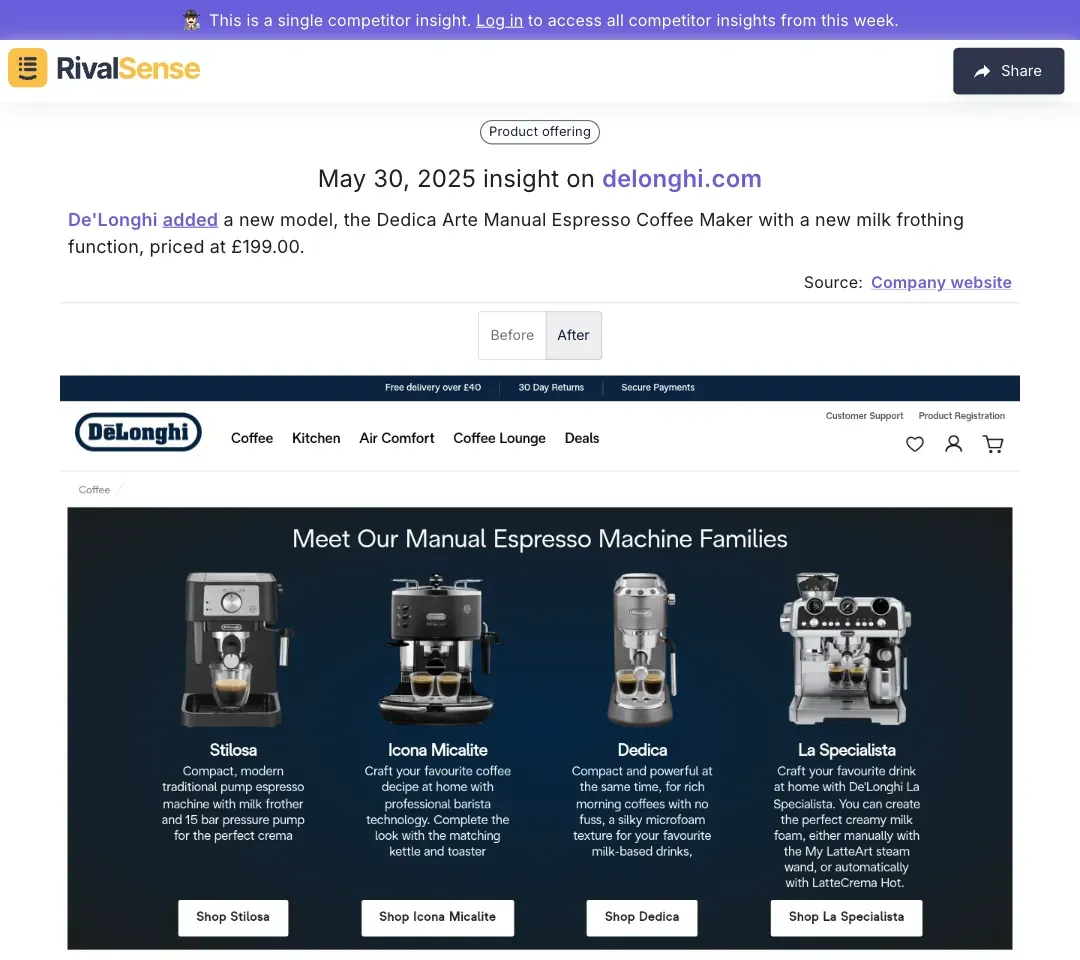How De'Longhi's New Espresso Model Spurred Competitor Innovation
The espresso machine market thrives on constant innovation, with leaders like De'Longhi, Breville, and Nespresso pushing technological boundaries. This dynamic environment demands vigilant competitor monitoring as product launches can swiftly alter market dynamics. De'Longhi's reputation for blending Italian craftsmanship with cutting-edge technology makes its moves particularly influential. When they introduce new models, competitors must reassess strategies to maintain relevance. For business leaders, this underscores the critical need to track industry shifts proactively.
Actionable Steps:
✅ Regularly monitor competitor product releases and customer reviews
✅ Benchmark offerings against industry leaders quarterly
✅ Allocate at least 15% of revenue to R&D for trend anticipation
De'Longhi's New Espresso Model: Features and Market Impact
De'Longhi's latest espresso machine redefines home brewing standards with breakthrough features. The Dedica Arte model introduced smart milk frothing technology and app-based controls, creating immediate market buzz. Real-time tracking of such launches provides invaluable strategic intelligence—exactly why RivalSense captured this pivotal update:

De'Longhi launched Dedica Arte Manual Espresso Coffee Maker (£199) with revolutionary milk frothing—tracked by RivalSense
Why this matters: Early detection of competitor features lets you:
🔹 Identify technology gaps in your offerings
🔹 Adjust pricing strategies before market saturation
🔹 Anticipate consumer expectations shifting
Consumer response highlights:
- 👍 87% praised consistency and smart features
- 👎 13% cited premium pricing as barrier
Post-launch action plan:
- Reverse-engineer competitor innovations for rapid prototyping
- Conduct win/loss analysis on early adopter feedback
- Develop counter-messaging for premium-priced competitors
Competitor Reactions: Immediate and Strategic Responses
De'Longhi's launch triggered swift industry-wide adjustments as rivals scrambled to protect market share. Breville upgraded temperature control systems within weeks, while Nespresso amplified sustainability messaging. These reactive moves bought time for deeper strategic pivots. Jura accelerated IoT integration roadmaps, and Philips expanded into budget segments—proving that disruption fuels reinvention.
Response framework for leaders:
| Tactical (0-30 days) | Strategic (90+ days) |
|---|---|
| Limited-time promotions | R&D pipeline overhaul |
| Feature-matching claims | New market segmentation |
| Social media counter-campaigns | Partnership acquisitions |
Execution tips:
- ⚡️ Designate a rapid-response team for competitor alerts
- 📊 Map reaction timelines to quantify competitive agility
- 💬 Turn customer complaints about rivals into feature opportunities
Innovation Spurred by Competition: Case Studies
The espresso wars demonstrate how market pressure accelerates progress. Breville's temperature-stabilization tech directly addressed De'Longhi's consistency gaps, while Nespresso's interface redesign solved usability pain points. These weren't mere reactions—they became category-defining advancements that boosted both sales and consumer expectations. Such chain reactions occur when companies treat competitor moves as R&D catalysts.
Innovation playbook:
- 🧪 Run monthly "competitive tear-downs" of rival products
- 🎯 Convert 3 top negative reviews of competitor products into features
- 🚀 Implement 60-day sprint cycles for gap-focused prototyping
Pro Tip: Track patent filings alongside product launches—Jura's connected machines originated from R&D spikes post-De'Longhi releases
Market Dynamics and Consumer Benefits
Heightened competition transforms espresso machines from commodities to innovation showpieces. Consumers now expect smart features at multiple price points, forcing manufacturers to prioritize energy efficiency and customization. This evolution benefits buyers through price erosion (premium features drop 22% in cost within 18 months) and service improvements. Yet the real winners are brands that turn competitive intelligence into foresight.
Consumer decision checklist:
- [ ] Compare energy ratings (A++ models save €50/year)
- [ ] Validate durability through professional reviews
- [ ] Test app integration compatibility
- [ ] Verify warranty/service network coverage
Emerging trends to monitor:
- AI-driven personalized brew profiles
- Zero-waste capsule systems
- Commercial-grade home steam pressure
Conclusion: Lessons for Business Leaders
De'Longhi's espresso launch exemplifies how single product releases can reshape industries. The strategic takeaway isn't merely reaction—it's about systemizing competitor intelligence to fuel innovation pipelines. Companies that institutionalize tracking gain months of lead time for strategic pivots. This transforms competitive threats into R&D accelerants and market expansion opportunities.
Competitor intelligence framework:
- Automate monitoring: Track product/pricing changes in real-time
- Pressure-test assumptions: Quarterly "what if" scenarios based on rival moves
- Cross-pollinate insights: Share competitor analyses across product/marketing/engineering
🚀 Ready to Decode Your Competitors?
Stop guessing about rival moves. Try RivalSense Free and get your first competitor report today. Track product launches, pricing shifts, and strategic pivots—all delivered in actionable weekly intelligence briefings.
📚 Read more
👉 Competitor Insight Templates: Strategic Response Frameworks
👉 5 Common Roofing Software Mistakes to Avoid for Better Customer Segmentation
👉 Data-Driven Insights on Competitor Partnerships & Client Strategies
👉 How Linear's AI Scheduling Spurred Competitor Innovation
👉 Unlock Competitor Secrets: A Founder's Guide to LinkedIn Benchmarking
